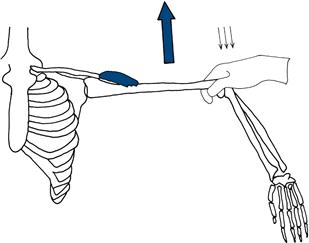Motor System
Arms
BACKGROUND
Upper motor neurone or pyramidal weakness predominantly affects finger extension, elbow extension and shoulder abduction. N.B. Elbow flexion and grip are relatively preserved.
Muscles are usually innervated by more than one nerve root. The exact distribution varies between individuals. The main root innervations and reflexes are shown in simplified form in Table 17.1. More detailed root distribution is given below.
Table 17.1
| Root | Movements | Reflex |
| C5 | Shoulder abduction, elbow flexion | Biceps |
| C6 | Elbow flexion (semi-pronated) | Supinator |
| C7 | Finger extension, elbow extension | Triceps |
| C8 | Finger flexors | Finger |
| T1 | Small muscles of the hand | No reflex |
The three nerves of greatest clinical importance in the arm are the radial, ulnar and median nerves.
• The radial nerve and its branches supply all extensors in the arm.
• The ulnar nerve supplies all intrinsic hand muscles except ‘LOAF’ (see below).
N.B. All intrinsic hand muscles are supplied by T1.
WHAT TO DO
Look at the arms
Basic screening examination
A simple screening procedure is outlined below. Some further muscle power tests are given afterwards. Perform each test on one side, then compare to the other side.
Shoulder abduction
Ask the patient to lift both his elbows out to the side (demonstrate). Ask him to push up (Fig. 17.1).

Figure 17.1 Testing shoulder abduction






